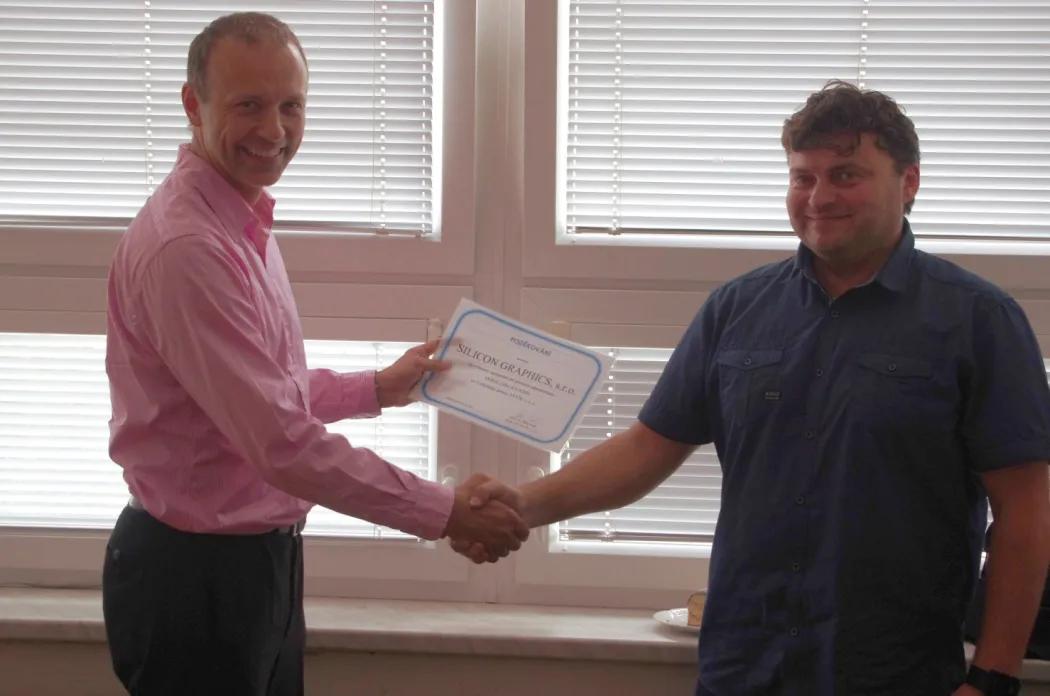Cluster Dorje was bought in November 2008 as new computing capacity for demanding scientific calculations in the area of solid states physics. At its time it was one of the most powerful supercomputers in the Czech Republic. Its theoretical power was 5.1 TeraFlops and the real measured one 4.2 TeraFlops.
It was a highly powerful system based on the GI Altix ICE 8200 system which was provided by SILICON GRAPHICS, s.r.o. The original set consisted of 64 compute nodes and 3 service servers. Each compute node was fitted with 2 four-core processors of Intel Xeon E5420 type, 2.50 GHz and 8 GB memory. Altogether 512 compute cores were available for scientific computations. Compute nodes were interconnected in InfiniBand network of 4x DDR type at the speed of 20 Gbit/s and as disc-less they shared one central disk space SGI InfiniteStorage220 of the 6 TB size. In the first three years the cluster was further extended by 1 TB memory and by further data field SGI InfiniteStorage5000 with 4 TB storage space.
The Cluster ran under the SUSE Linux Enterprise Server operating system with the software extension SGI ProPack and SGI Foundation Software. The whole system was administered using the SGI Tempo tool.
After installation and tests the cluster was ceremonially put to operation in the spring of 2009. It worked without big problems and almost non-stop until the end of September 2018 when its operation was officially ended. It was definitely switched off on 30 January 2015 to free space of a new cluster.
For the duration of its operation 180 thousand tasks was started which means 22.5 thousand tasks a year on average, i.e. 1900 tasks a month. More than 15.5 million hours of machine time was used for computing, i.e. 650 thousand days, 1 783 years. The detailed statistics of the use was described in publication [1].
Dorje cluster was used to solve a number of problems from the area of solid states physics, e.g. Looking for new materials for future applications in the so called spin electronics, studies of magnetic properties of artificially prepared thin layers and nanostructures, studies of galvano-magnetic properties of magnetic materials with a complicated grid structure, the research of electron structure, magnetic and optical properties of solids, computations of electron and atom structure of surfaces and atom clusters including the simulation of the interaction of the microscope probe with the studied surface, or the study of magneto-crystalline anisotropy of monolayers and absorbed atoms on precious metal surfaces. The results of the computations were published in more than 110 scientific articles and were presented at a number of conferences, workshops and seminars.
The purchase of the cluster was financed by the Grant Agency of the Czech Academy of Sciences as part of the Nanotechnologies for the Society programme of the “Functional Hybrid Nanosytsems of Semiconductors and Metals with Organic Substances” project (KAN400100701) and by the Grant Agency of the Czech Republic, “Impurities and Defects in Magnetit” (202/08/0541). The cluster operation was supported by the funds of the FZU.
The successor of the Dorje cluster was Luna2013 cluster purchased in December 2013. The new cluster is integrated to the MetaCentrum environment. It consists of 47 compute nodes of the SuperMicro SuperServer 6017R‑NTF type. Each compute node is fitted with 2 eight-core processors Intel Xeon E5‑2650 v2, 2.6 GHz, 96 GB memory and local disc of the 800 GB size. The compute nodes are interconnected by InfiniBand network of 4x QDR type with the speed of 40 Gbit/s. Altogether 752 compute cores were available for scientific computations and 4.5 TB of memory. The theoretical power of the whole cluster is 15.6 TeraFlops, which means three times the power of the Dorje cluster. Users have been using Luna2013 cluster since January 2014.
Links:
[1] Klastr Dorje: SGI Altix ICE 8200, J. Uhlířová a J. Chudoba (editoři), [online] http://www.fzu.cz/sites/default/files/klastr_Dorje_2008-2014.pdf, ISBN 978-80-905962-0-7 201


